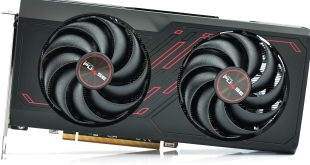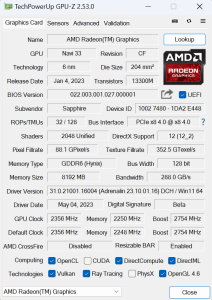
Following on from the recent launch of AMD's RX 7600 GPU, today we take a look at the Sapphire Pulse partner card. The Pulse series has firmly established itself as a bang-for-buck favourite since its inception in 2017 and that looks to be no different for this RX 7600 model. Hitting the market at £259.99, it's an MSRP card that offers a factory overclock, dual-fan cooler and metal backplate. Today we find out how it compares against AMD's reference design.
While the Sapphire Pulse lineup may not be quite so feature-packed as the more expensive Nitro+ series, you typically know what you are getting with a Pulse card – good build quality, an effective cooler and usually just a small price premium over the baseline MSRP. In this case, there's no price premium for the Sapphire RX 7600 Pulse model as it's on sale for £259.99, the same figure AMD quotes as the baseline MSRP for the RX 7600.
Today, we look at gaming performance, thermals, acoustics, overclocking and more to find out exactly how the Pulse compares to AMD's own reference card…
| RX 6700 XT | RX 6650 XT | RX 6600 XT | RX 6600 | RX 7600 | |
| Architecture | RDNA 2 | RDNA 2 | RDNA 2 | RDNA 2 | RDNA 3 |
| Manufacturing Process | 7nm | 7nm | 7nm | 7nm | 6nm |
| Transistor Count | 17.2 billion | 11.1 billion | 11.1 billion | 11.1 billion | 13.3 billion |
| Die Size | 336 mm² | 237 mm² | 237 mm² | 237 mm² | 204 mm² |
| Compute Units | 40 | 32 | 32 | 28 | 32 |
| Ray Accelerators | 40 | 32 | 32 | 28 | 32 |
| Stream Processors | 2560 | 2048 | 2048 | 1792 | 2048 |
| Game GPU Clock | Up to 2424MHz | Up to 2410MHz | Up to 2359MHz | Up to 2044 MHz | 2250 MHz |
| Boost GPU Clock | Up to 2581MHz | Up to 2635MHz | Up to 2589MHz | Up to 2491MHz | Up to 2625MHz |
| ROPs | 64 | 64 | 64 | 64 | 64 |
| AMD Infinity Cache | 96MB | 32MB | 32MB | 32MB | 32MB |
| Memory | 12GB GDDR6 16Gbps | 8GB GDDR6 17.5Gbps | 8GB GDDR6 16Gbps | 8GB GDDR6 14Gbps | 8GB GDDR6 18Gbps |
| Memory Bandwidth | 384 GB/s | 280 GB/s | 256 GB/s | 224 GB/s | 288 GB/s |
| Memory Interface | 192-bit | 128-bit | 128-bit | 128-bit | 128-bit |
| Board Power | 230W | 180W | 160W | 132W | 165W |
First, let's take a quick look at the specs. Still based on the RDNA 3 architecture, things are slightly different to what we saw with the RX 7900 XTX and 7900 XT. For one, the chiplet-based design has reverted to a monolithic die, and instead of using TSMC's 5nm process, Navi 33 makes use of 6nm, with a 204 mm² die size.
Internally though, the compute makeup hasn't been radically changed. Navi 33 packs in 32 Compute Units, each of which houses 64 Stream Processors, for a total of 2048 shaders. There's also 32 Ray Accelerators – one per CU – and 64 ROPs.
As for clock speed, this remains high with the RX 7600, with AMD touting a boost of up to 2625MHz, though a slightly lower game clock of 2250MHz. Sapphire has increased this with the Pulse model, with a boost clock of 2755MHz, and a game clock rated at 2355MHz.
Meanwhile, the memory configuration is almost identical to the previous generation RX 6600. We still find 8GB GDDR6 operating over a 128-bit interface, but this time the memory clocks in at 18Gbps, up from 14Gbps. This gives a memory bandwidth of 288 GB/s, though AMD claims an ‘effective' bandwidth of 476.9 GB/s due to the 32MB of 2nd Gen Infinity cache.
As with Navi 23, Navi 33 also features a cut-down PCIe interface, offering a Gen4 x8 connection.
Power draw for the reference RX 7600 is rated at 165W Total Board Power (TBP), an increase from the 132W figure for the RX 6600. Sapphire is claiming a slightly higher 185W TBP for the Pulse model.
 KitGuru KitGuru.net – Tech News | Hardware News | Hardware Reviews | IOS | Mobile | Gaming | Graphics Cards
KitGuru KitGuru.net – Tech News | Hardware News | Hardware Reviews | IOS | Mobile | Gaming | Graphics Cards




